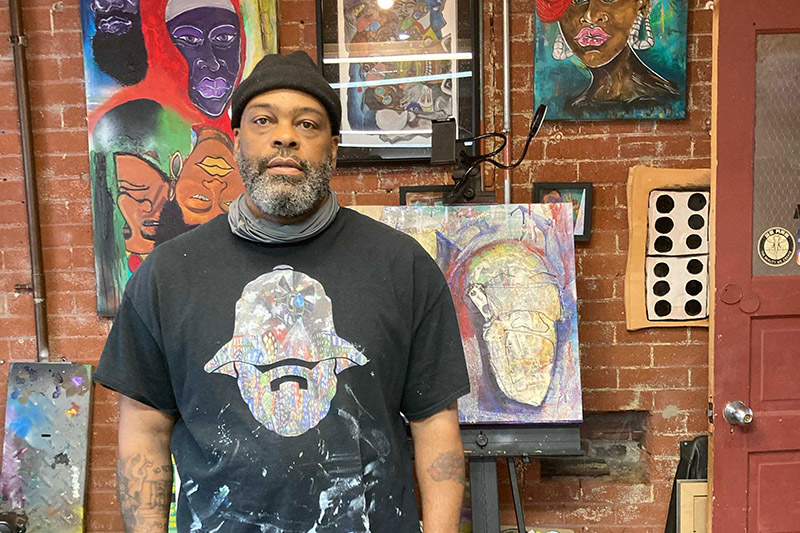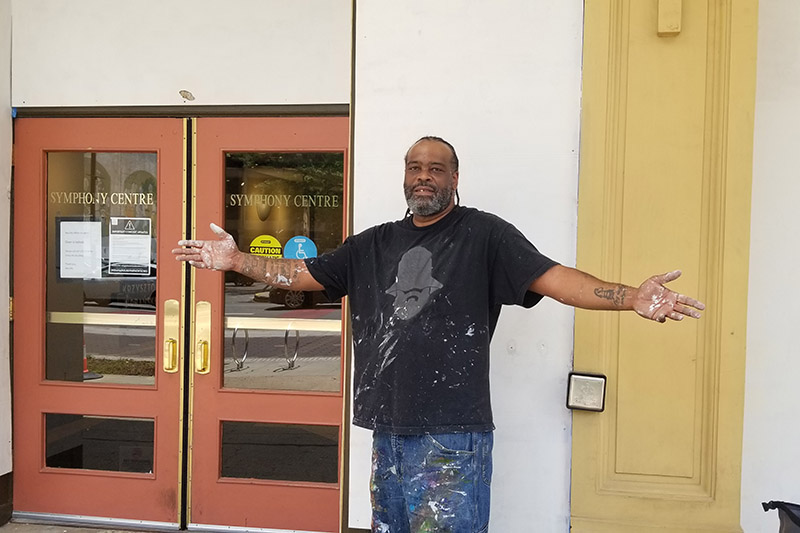Published May 17, 2021
Meet the Artist: Gary Gee
Over eight days in June 2020, artist Gary Gee painted 11 panels that covered the windows of the Indianapolis Symphony Orchestra offices at 32 E. Washington St. Two of those, “8:46” and “We the People…” will be part of the new exhibition, “RESPONSE: Images and Sounds of a Movement,” in the Indiana State Museum’s Legacy Theater from June 5-Sept. 6.
“I wanted to get people walking by or driving by to stop and look,” Gee said.
When they did, they saw striking images.
“8:46” shows George Floyd in a crown and the words “8 minutes 46 seconds that changed the world,” a reference to Minneapolis police officer Derek Chauvin kneeling on Floyd’s neck for eight minutes and 46 seconds, resulting in his death. “We the People…” depicts people of all different races and nationalities – along with the Statue of Liberty – marching together under a banner that says, “We the people hold these truths 2 be self-evident.”
It leaves unfinished the sentence from the Declaration of Independence that declares “all men are created equal.”
Gee, who turns 50 in June, was born and raised in Indianapolis, mostly in the Spades Park area of Brookside and Martindale-Brightwood. As a child, he would draw on paper bags, envelopes – any blank surface. In sixth grade, his mother bought him a professional art kit. He earned art scholarships in junior high for Saturday School at Herron School of Art + Design at IUPUI and later for the Summer Arts Institute at Indiana University-Bloomington. He also took art classes at Arsenal Technical and Arlington high schools.
Gee became a professional artist in 2016 after taking a circuitous route from the military to odd jobs, music recording, prison (for a drug conviction that was overturned after 3½ years), hair school, degrees in both visual communication and fine arts from Ivy Tech and a bachelor’s degree from Herron in 2016. You can find Gary Gee on Instagram and at his website, artbygarygee.com.
In an interview, he talked about his work in RESPONSE.
Tell me about your pieces in the exhibit.
“8:46” is the eight minutes and 46 seconds that the world stood still. That’s how I was looking at it. No matter where you were, who you were, you were affected by it, no matter which side of the equation you were on. It was like a breaking point in modern society. George Floyd was the tipping point, the shot heard ’round the world. I left it in black, white and red, like it was a bold newspaper headline.
With “We the People…,” I had the idea of what I wanted to do, but I was adding layers and context as I interacted with people on the street and people in my social media. I was looking at it from the standpoint of the Constitution. Even when it was written, it wasn’t really written for everybody. But it’s like, “We the people hold these truths to be self-evident.” So, I was thinking that we the people saw what happened, and the truth was self-evident. There was no question.
Did you do these on your own, or did you have help?
I was offered help, but at the time, I felt it was important for me as a Black man to get this narrative out of my head. And at the same time, there were parts where I really didn’t know what I was doing. So, when people said I can help you, I didn’t know what I wanted them to do because I had these complex thoughts swirling around my head and I wanted to do this myself.
Did you get any grief, or were people cool?
For the most part, everyone was cool. I had one guy who grabbed a spray paint can and was going to spray a building. I grabbed the guy and got him out of there. But there was a lot of support. I had a couple of suburban moms from Hamilton County stop to talk, and we had some pretty cool conversations. One of them sent her son down the next day, and he came with his best friend. They were 17, 18. We had conversations about politics and how they are the change. Sometimes things have to get bad before they can get better.
What is it like having your work on display at the museum?
It’s definitely an honor to have my artwork in the museum, but also to be part of a meaningful exhibition that’s impactful at this historic moment in time. Some kids dream of hitting the last shot at the end of a big game. This is that shot for this kid.
What do you want people to take away from your work that they see at the museum?
I like to evoke conversation. So, I would hope that someone takes away a different perspective. Or, if their perspective aligns with mine, I hope it helps them expand on that. Or that they invite someone else to look at the work or engage with the piece.
Anything else you want people to know about you or your work?
Everything I do comes from the heart – or my gut. It’s real feeling. I don’t set out to copy or mimic anybody. I have a lot of artistic and musical influences that are part of my work, but really, it’s pure emotion.
About RESPONSE:
Like much of the nation, Indianapolis experienced days of protests in June 2020. Artists stepped up to quickly express their frustrations and hopes. Now, one year later, the Indiana State Museum, Arts Council of Indianapolis and the Indianapolis Public Library are teaming up to present exhibitions of murals painted by these artists after the protests, and hold discussions designed to increase community understanding of what occurred and why. Visit Legacy Theater on Level One from June 5 to Sept. 6, 2021 to see the six murals painted by Indianapolis artists and business owners. This exhibit is free to the public.











